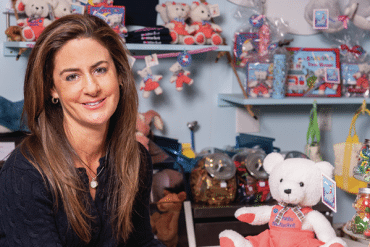 The Kennedy family was gathered at their compound in Hyannis some forty-five years ago, and Frederick Clow was photographing them on the lawn overlooking the water. He’d been there before, and he’d be there again—cameras around his neck, clicking and winding, in and out of conversations— covering the family, getting to know them, Ted Kennedy in particular. A practiced eye behind the lens, Clow observed and documented public events and quiet moments in the lives of the Kennedys for decades.
The Kennedy family was gathered at their compound in Hyannis some forty-five years ago, and Frederick Clow was photographing them on the lawn overlooking the water. He’d been there before, and he’d be there again—cameras around his neck, clicking and winding, in and out of conversations— covering the family, getting to know them, Ted Kennedy in particular. A practiced eye behind the lens, Clow observed and documented public events and quiet moments in the lives of the Kennedys for decades.
On that particular afternoon on the Cape, Clow decided he’d take a trip. He left the Kennedy com- pound, made his way to the docks, and boarded the ferry for Nantucket. He’d never been before. “I walked up Main Street and I made a decision,” he says. He vowed then and there that he’d live on the island someday. He made good on the promise in 1968 when he bought a house on Lyon Street. Today, Clow still considers Nantucket home, despite a business card that lists addresses in Boston’s Mission Hill neighborhood, as well as in Nova Scotia.
A photojournalist for half a century, Frederick Clow is the type of person who gets what he wants, not by elbowing or barging, not by being brash or bullying, but with focus and deter- mined politeness. Perhaps most importantly and rare, he knows exactly what he wants and how to ask for it. It’s a story that repeats itself as we sit at a banquette against a wall covered with photographs of sports stars, actors and politicians at Leo’s, the oldest diner in Harvard Square in Cambridge, Massachusetts. Clow is eighty-one years old, but the spark in his eye, the firm grip of his handshake and his head of full, floppy white hair belies his age.
We’re in a good place, Clow remarks on the address. “We’re sitting at 35 JFK Street,” he says, “and JFK was our thirty-fifth president.” He’s got a hard briefcase with him, and he lays it on the counter, clicks it open and pulls out a folder thick with black-and-white prints of the Kennedys, Barack Obama, Martin Luther King, Ronald Reagan, Richard Nixon, Ella Fitzgerald, John Kerry, Winston Churchill and many more. There are many photos of the Kennedys. A friendship was forged with Ted Kennedy; the late Senator wrote the foreword to the book of photo- graphs Clow is working on.
His instincts for getting exclusive shots started early. In 1949, when he was eighteen years old, a Boston cop gave him a tip that Jawaharlal Nehru, the first prime minister of India, would be leaving a local hotel at a certain time. Clow came ready with his camera and shot a picture of Nehru and his sister in traditional dress. He took the image to the Boston Post, but was met with ambivalence from the editor there. “It was defeating the way he talked about it,” he says. Fortunately, Grace Davidson, the society editor at the time, happened to overhear the conversation. “‘Print it up,’ she said. She used it in the Sunday Post, and I got paid five dollars,” Clow explains. “This lady saved my life.” It was his first published photograph. And, as Clow says, “It happened the first time I walked in the door.” So he kept walking in the door.
In the Air Force, he was thrown into the supply section, not where he wanted to be. He put his photos in his briefcase, defied protocol and went directly to the colonel. “I showed him my photographs and I told him that I signed up to be a photographer.” The colonel said, “We’re working on it.” And Clow said, “Colonel, I’m an impatient man.” The colonel leaned back in his chair and gave Clow a hard look. He picked up his telephone and made a call and said, “I’m sending you a guy with a lot of promise.” Clow smiles in the telling. “I’ve got a way with people,” he says. “I don’t slam dunk people. I don’t smother. I try to be as natural as I can.” He pauses here and laughs to himself. “People get the message.” Eleanor Roosevelt got the message when Clow slipped into the backseat of a car with her. How did she react? Clow shuffles through the photographs and shows me the answer. There’s Mrs. Roosevelt, her face filling most of the frame, beaming a smile of surprise.
Clow considers himself a natural, and you can’t blame him, having photographed some of the most iconic figures of the 20th century. He shows me a portrait of Martin Luther King. King has a mischievous smile on his face, a winking sort of impishness. “As soon as he stood at the podium, it was all business,” Clow says. The next shot shows the reverend speaking, eyes clear, mid-word, mouth open as though in song. As he tours me through his photographs, there’s one image we linger on. It’s John F. Kennedy and Jackie Kennedy in the back seat of a limo. They’re on their way to the White House after the inauguration ceremony. Secret service men flank the car on foot. Kennedy, in a glossy top hat, waves to the crowds. The first lady sits composed on his left, hands tucked in a fur muffler, a smile on her face. It’s an eerie image, one that immediately conjures the limo ride in Dallas on that fateful day in November 1963.
Clow puts his finger down on one of the men on foot at the side of the car. That’s Clint Hill, he explains. That’s the man who threw himself on the back of the limo on that day in Dallas, who covered the body of the president and the first lady with his body. Clow met Hill this past August in Hyannis. “I introduced myself,” Clow says. “He grabbed my hand and I started to cry.” Clow’s voice gets latched in his throat here and his eyes cloud over. “This man threw himself on the car. This man cradled the late president. President Kennedy died in his arms.” Hill lives in Arlington, Virginia, less than a mile from the cemetery where Kennedy is buried, Clow says. “You don’t have to be a psychiatrist to know what that’s about,” he says. “That’s powerful stuff.”
Clow collects himself. We move on to other images, and finally he asks if I’d seen the one of him up on the wall there at Leo’s. I hadn’t. We move towards the window and there’s Clow with Martin Luther King at the New England Conservatory, Clow smiling, King, grave-faced. There’d been a bomb threat that day. Clow says, “You can understand why he had such a tense face.” King and Clow were neighbors in the South End in Boston for a time while King studied at Boston University. “I like to think that maybe he saw me around,” Clow says, “that maybe he knew my face.”





